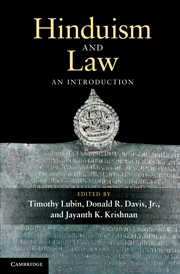Book contents
- Frontmatter
- Contents
- List of contributors
- Acknowledgements
- Chronology
- Abbreviations
- Map South Asia: political divisions c. 1860 and today
- Introduction
- Part I Hindu law
- Chapter 1 A historical overview of Hindu law
- Chapter 2 Dharmaśāstra
- Chapter 3 The practice of classical Hindu law
- Chapter 4 The creation of Anglo-Hindu law
- Chapter 5 Marriage and family in colonial Hindu law
- Chapter 6 Hindu law as personal law
- Part II Law in ancient and medieval Hindu traditions
- Part III Law and modern Hinduism
- Glossary
- Bibliography
- Index
Chapter 3 - The practice of classical Hindu law
Published online by Cambridge University Press: 05 June 2012
- Frontmatter
- Contents
- List of contributors
- Acknowledgements
- Chronology
- Abbreviations
- Map South Asia: political divisions c. 1860 and today
- Introduction
- Part I Hindu law
- Chapter 1 A historical overview of Hindu law
- Chapter 2 Dharmaśāstra
- Chapter 3 The practice of classical Hindu law
- Chapter 4 The creation of Anglo-Hindu law
- Chapter 5 Marriage and family in colonial Hindu law
- Chapter 6 Hindu law as personal law
- Part II Law in ancient and medieval Hindu traditions
- Part III Law and modern Hinduism
- Glossary
- Bibliography
- Index
Summary
Introduction
To what extent has Hindu law been applied in the premodern juridical and legal procedure of South Asia? To what extent was the Dharmaśāstra an applied source of jurisdiction? These questions have puzzled and troubled many scholars of classical Hindu law. Some scholars opine that the Dharmaśāstra is concerned with law cases decided by concerned bodies (corporate groups, administrative institutions of rulers, temple authorities): “There can be no doubt that the smriti rules were concerned with the practical administration of law” (John D. Mayne as quoted by L. Rocher 1978: 1,299). Other scholars believe that the Dharmaśāstra is purely or mostly concerned with moral and religious norms which have some but not a very close relationship to legal practice, or that the smṛtis did not embody the law of the land but were entirely scholarly texts or commentaries on ancient authoritative texts. It was also argued that Hindu law was administered on the basis of unwritten maxims, floating verses of rules preserved by memorization and partly written down into Sanskrit law books, most of them applicable to specific social groups and castes only, so that it should be understood as a record of regional customs but not just as legal codes or Brahmanical moral fantasies.
No doubt, with the exception of Warren Hastings’s Judicial Plan of 1772, when Brahmin pandits were attached to Anglo-Indian courts and the Dharmaśāstra literature partly gained the status of legislation, classical Hindu law was never codified law sensu stricto. Although it is debated to what extent custom has influenced or even shaped classical Hindu law, it is now generally accepted that until 1772 Hindu law by and large was a local and regional affair, despite its cosmopolitan claims (see Chapter 1), and local customs and regional laws have profoundly influenced the Brahmanical norms of the Dharmaśāstra. The Dharmaśāstra itself acknowledges that various laws are specific to country, family, lineage, castes, women, or even animals (deśa-, kula-, jāti-, strī-, or paśudharma) – the latter rather being a form of non-dharma (MDh 9.66). (Pre-modern) Hindu law therefore also incorporates many non-Brahmanical sources and is thus more than Dharmaśāstra. The word “dharma” does not even appear in a number of legal sources (D. R. Davis 2004a: 18).
- Type
- Chapter
- Information
- Hinduism and LawAn Introduction, pp. 58 - 77Publisher: Cambridge University PressPrint publication year: 2010
- 5
- Cited by

